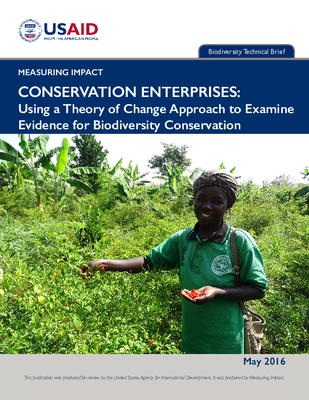Conservation Enterprises: Using a Theory of Change Approach to Examine Evidence for Biodiversity Conservation

In this brief, the United States Agency for International Development (USAID) Bureau for Economic Growth, Education, and Environment (E3) Office of Forestry and Biodiversity (FAB) Measuring Impact (MI) project examined the evidence presented in the studies included in Roe et al.’s systematic review of alternative livelihood activites. MI examined the evidence in these studies relative to the assumptions in the theory of change described for conservation enterprises. Key findings include the following: 1) None of the assessments of activities supporting conservation enterprises were designed with a clear theory of change making it difficult to relate some of the outcomes that were measured to the assumptions underlying the strategic approach; 2) Most established enterprises generated economic benefits; 3) Economic benefits co-occurred with positive changes in behavior only about half the time; and 4) There was virtually no assessment of whether changes in behavior led to threat reduction.
Information relevant to Learning Questions:
Are they enabling conditions in place to support a sustainable enterprise?
- Diversification
- Market demand, profit potential, access to credit / capital
- Ownership, governance
- Government requirements
- Financial management capacity, technical capacity
- Inputs, equipment, infrastructure
- Benefit sharing, biodiversity linkage, external disturbance
Does the enterprise lead to benefits to stakeholders?
- Increased income for participants
- Non-cash benefits
Do the benefits lead to positive changes in attitudes and behavior?
- Attitudes regarding sustainable use of resources
- Behaviors regarding sustainable use of resources
Does a change in stakeholders’ behaviors lead to a reduction to threats to biodiversity (or restoration)?
- Addressed generally
Does a reduction in threats (or restoration) lead to conservation?
Addressed generally
Enterprise Types:
- Crops
- Livestock
- Sustainably harvested timber products
- Non-timber forest products
- Sustainably harvested fish and shellfish
- Aquaculture and mariculture: seaweed farming
- Terrestrial ecotourism
- Other natural products: handicrafts, butterfly farming
- Other businesses: conservation-oriented language school
Document type:
- Assessment Report

